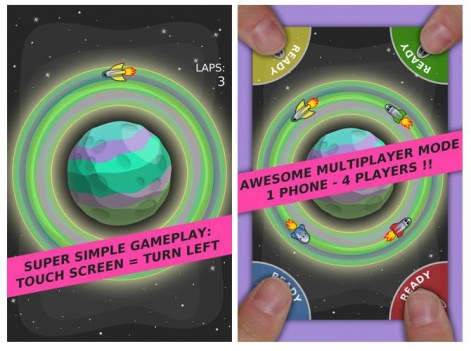Through their publishing company Zee-3, the pair recently launched an indie cross-promotion campaign called Games We Like.
You can find part one of the PocketGamer.biz Games We Like column series here.
As game designers who've spent most of our careers developing console games, John and I are fascinated by the touch screens we're allowed to play with now we're making mobile games.
After all, designing for touch screen is fundamentally different to designing for buttons and joysticks. Or it is if you want to do it well.
Turn-based games may work fine with on-screen buttons, but for direct control of anything that moves, the game designer really needs to invent a control scheme that plays to the strengths of the touch screen, rather than shoe-horning in button based controls via the dreaded virtual joystick (shudder!).
Feeding back
This isn't straightforward. Touch-based control for games is a fairly new field. There aren't established standards yet, and there are almost certainly great ideas that haven't yet been invented.
But fundamentally, a good touch-based control scheme should feed into the game design itself, influencing the features and the structure of the game itself.
As an illustration, I'm going to discuss a couple of Games We Like that are based around the beautifully simple idea of using whole screen as a single button, and see at how they ended up with very similar game mechanics and game structures while being superficially quite different.
Lap it up
Lap Uranus is a really simple game we've already name-checked in our Games We Like list.

In it, you control a spaceship orbiting a planet and your aim is to circle this celestial body as many times as you can. Rather than directly controlling the ship's thrust you simply touch the screen to turn the ship.
From this you get a surprisingly subtle level of control over the ever-accelerating rocket, with a lot of scope for skilful play and for messing up.
This is great design for a mobile game. The single control not only makes the game incredibly easy to understand and play (perfect for non-gamers), but the ability to touch anywhere on the screen is ideal for a device that is going to be used and held in a variety of different ways.
Swings and roundabouts
Slingshot Racing uses a similar touch-to-turn control method, but with a twist.

It's a driving game with twisting tracks, and is therefore attempting something far more complicated with the same controls. Here the single touch of the screen causes a wire to appear, attaching the player's car to the nearest tower (these are positioned on each corner).
The car will then 'slingshot' around that tower in a similar manner to the rocket in Lap Uranus.
So a single touch, on or off, is being used to control direction, speed, and the closeness to the ideal 'racing line'. Beautiful!
It's a little harder to master than Lap Uranus, but straight away it's clear that there is scope to minimise the length of a lap and overtake several opponents in a single turn, as well as mess up completely and go from first to last with a poorly timed tap of the screen.
Influence versus cloning
Neither of these games is a clone of the other, although they have some similarities because they've been built around the same control scheme.
However, if either one was inspired by the other (and I'm not suggesting they were), then they would be a great example of how influence should work in video games, with designers taking a key concept from one game (touch-to-turn), and building a whole new game around that idea.
This is distinct from cloning, where developers takes the whole package of a game - control scheme, mechanics, setting, theme, structure, balance, graphic style - and just re-skin it.
Interestingly, both games have a simultaneous 4 player mode, where each player gets a corner of the screen to control their own spaceship / car.
This is a clever use of multi-touch which would be almost impossible with more complex on-screen buttons, and hints at an interesting new form of single-screen social gaming which, like board games and card games, allows the possibility of cheating.
Games we like
It's unlikely that either game would have been designed like this for a platform with a controller attached.
With a joystick under your thumb it would make no sense not to be able to fully control vehicle direction, and with multiple buttons available it would make no sense not to have a brake or boost control in addition to accelerate. And yet these are two brilliant games which may perfect sense in their own right.
We like games that truly make sense on the platform they were built for.
You can find out more about Zee-3, including some of the Games It Likes, on the company's website.
You can also follow Ste Pickford, John Pickford, and The Pickford Bros on Twitter.





















